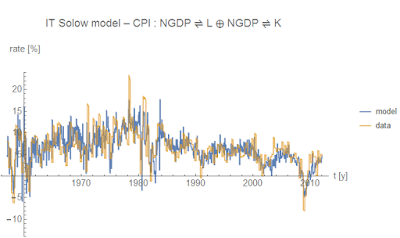Some of the problems with the "quantity theory of labor" is 1) it doesn't work for the UK, and 2) it underestimates RGDP.
What about the Solow model? It was very accurate as a model of NGDP. And it is accurate for UK. Let me lay out the model. Consider two simultaneous markets (employed labor and nominal capital) with core CPI being the detector in the labor market:
X : NGDP ⇄ K
The X is an irrelevant price in the capital market [ed. note: actually, it's technically the capital deflator]. We can solve these markets for the general equilibrium (as in the paper):
CPI ≡ dNGDP/dL = (n0/l0) β (L/l0)ᵝ⁻¹(K/k0)ᵞ
The only other detail is that I used core CPI to inflate real capital to obtain nominal capital (the result does not change much if you use e.g. the GDP deflator). Capital stock only goes until 2012 on FRED as well.
So how does this perform? In a word, brilliantly:
[mic drop]
[picks mic back up]
Oh, wait -- so does this help us with why the quantity theory of labor performs poorly for the UK? Yes, it does. The UK (in this model) is much more capital intensive than the US or Canada. In the US (above), we have β = 0.8 and γ = 0.7, but the UK has β = 0.5 and γ = 1.0 -- meaning the capital component contains much more of the variation.
[picks mic back up ... again]
Also the IT Solow model doesn't require β + γ = 1.
[mic drop ... again]
[fumbling around for the opening in the curtain]
...
Update 17 March 2016
...
Update 17 March 2016
Commenter Marko gave me a link to the deflator for that real capital series, so here's the update to the model results ... not much change:






"Also the IT Solow model doesn't require β + γ = 1"
ReplyDeleteNeither does the normal Solow model...
The normal Solow model only requires decreasing returns to capital, increasing returns to labor is fine, but weird (non-technology related growth in equilibrium). In addition, there can be decreasing returns to both with increasing returns on a whole and the model still functions fine.
I guess I should have said "assumes" ... I think the quote is that it's just the kind of assumption one makes.
DeleteAh, here it is:
DeleteConstant returns to scale seems the natural assumption to make in a theory of growth.
Solow (1956)
Now that is cool!
ReplyDeleteJason, very nice. Time for me to put on my dunce cap: I don't get the mic drop & curtain joke. Are you just expressing surprise? Is it a Wizard of Oz reference? Lol... I'm not sure.
ReplyDeleteI imagine there is a reference somewhere in my subconscious, but it's not intended as a specific reference.
DeleteI'm imagining you backstage in your tux and bow tie... the stage lights are hot,... the crowd is murmuring and restless with anticipation... you open the envelope with trembling fingers... don't let this be your Steve Harvey moment!! Lol
DeleteFRED has a matching deflator for the capital stock series you used :
ReplyDeletehttps://research.stlouisfed.org/fred2/series/PLKCPPUSA670NRUG
It's pretty much identical to gdpdef , which you already checked , so this is just for purposes of general interest.
Marko
Thank you very much!
DeleteAnd yes, it does work about the same. I will update the post, however.